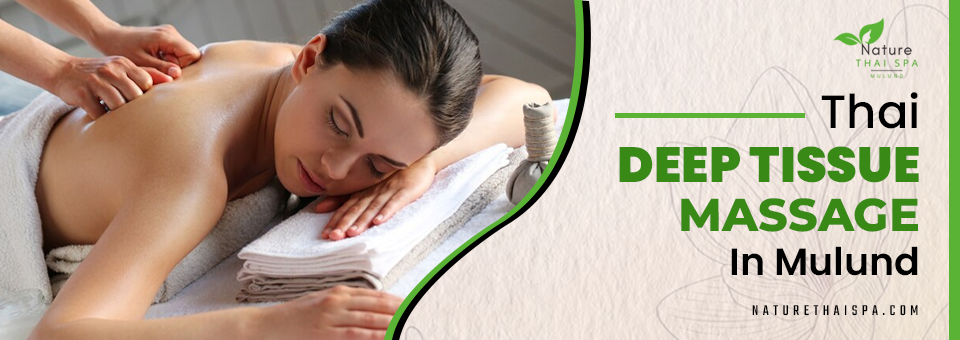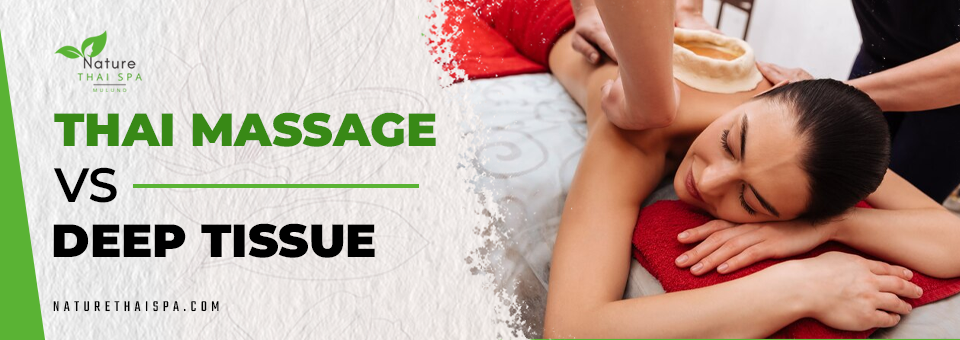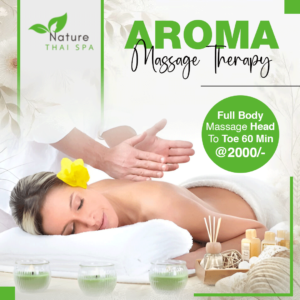Table of Contents
- Thai Massage: An Ancient Healing Art
- Deep Tissue Massage for Targeting Deeper Layers
- Comparing The Techniques – What to Expect
- The Experience of Deep Tissue Massage
- Comparing Thai Massage Vs Deep Tissue for You
- Who Should Avoid These Massages?
- Enhancing Your Massage Experience: Tips & Tricks
- Incorporating Massages into Your Wellness Routine
- Final Thoughts
Are you struggling with chronic pain or persistent tension? Are you anxious and in need of relaxation? The right massage can transform your well-being. You may heard about Thai and Deep Tissue massages, these are popular choices for alleviating pain as well as stress. That’s why many of us get confused regarding Thai massage vs Deep Tissue, which one to choose.
However, choosing between them can be challenging. In this blog, we will explore the unique benefits of each massage type to help you decide which one suits your needs best.
Thai Massage: An Ancient Healing Art
Thai massage, originating in Thailand over 2,500 years ago, combines acupressure, yoga, and Ayurveda principles. Unlike traditional Western massages, Thai massage involves stretching and deep pressure techniques.
The therapist uses hands, knees, legs, and feet to move you into various positions, enhancing flexibility and joint function. Therefore, this unique approach targets the entire body, promoting balance and relaxation.
Benefits of Thai Massage
Thai massage offers numerous benefits beyond relaxation.
- It promotes circulation, lowers muscular tension, as well as increases flexibility.
- Regular sessions can also boost energy levels and mental clarity.
- Additionally, Thai massage supports the body’s natural healing processes by stimulating the flow of energy.
So, if you seek a holistic approach to wellness, Thai massage might be the ideal choice.
Deep Tissue Massage for Targeting Deeper Layers
Deep Tissue massage focuses on realigning deeper muscle layers and connective tissues. This technique is beneficial for individuals with chronic pain, muscle injuries, or postural problems.
Unlike Thai massage, Deep Tissue massage uses slow, deep strokes and firm pressure to release tension in specific areas. Hence, it’s particularly effective for treating stiff necks, lower back pain, and tight shoulders.
Benefits of Deep Tissue Massage
Deep Tissue massage is renowned for its ability to relieve chronic pain.
- It breaks down scar tissue and reduces inflammation.
- This massage type also improves blood flow and helps eliminate toxins from muscles.
- Regular sessions can enhance mobility and reduce the risk of injury.
If you experience chronic pain or have specific problem areas and if you’re confused about Thai massage vs Deep Tissue, Deep Tissue massage may be your best option.
Comparing The Techniques – What to Expect
The Experience of Thai Massage
Thai massage involves dynamic movements and stretches; thus, making it a more active experience. You may be asked to change positions frequently. The therapist might use hands, knees, legs, and feet to perform various techniques.
Moreover, such movements are designed to stretch and compress the muscles, joints, and energy lines. Thai massage sessions typically last between 60 to 90 minutes and are conducted on a mat on the floor, with the recipient remaining fully clothed.
Key Aspects of Thai Massage
- Active participation with the therapist.
- Emphasis on stretching and yoga-like positions.
- Use of rhythmic compressions and rocking movements.
- Focus on energy lines (Sen lines) and acupressure points.
- Conducted on a floor mat with comfortable clothing.
The Experience of Deep Tissue Massage
Conversely, Deep Tissue massage is more focused and less active. The therapist works on specific muscle groups, applying consistent pressure. Thai deep tissue massage in Mulund uses slow strokes and firm pressure to reach deeper layers of muscle and fascia.
This method helps to break down adhesions and relieve chronic muscle tension. Sessions typically last between 60 to 90 minutes and are conducted on a massage table, with the recipient partially or fully undressed and covered by a sheet.

Key Aspects of Deep Tissue Massage
- Focused on specific problem areas.
- Use of slow, deep strokes and firm pressure.
- Aimed at releasing chronic muscle tension and breaking down scar tissue.
- Performed on a massage table with proper draping.
- May cause some discomfort during the process.
Comparing Thai Massage Vs Deep Tissue for You
In this part of this blog, we are going to compare Thai massage and Deep Tissue, so that you can take the most suitable massage for you.
Pressure & Intensity
Thai massage provides a gentle and flowing experience, despite the stretches and movements involved. The intensity may be adjusted to your level of ease or comfort. Deep Tissue massage, however, tends to be more intense due to the deep pressure applied to specific areas. To guarantee a pleasant encounter, share your pain threshold with your masseur.
- Thai Massage: Gentle to moderate intensity with flowing movements.
- Deep Tissue Massage: Higher intensity with focused, deep pressure.
Comparing Techniques & Movements
Are you struggling with Thai massage vs Deep Tissue; which one has better techniques? This is what we are about to answer.
Thai massage incorporates a variety of techniques, including acupressure, joint mobilization, and assisted yoga stretches. These movements are synchronized with your breathing to promote relaxation and energy flow.
Deep Tissue massage, on the other hand, relies heavily on slow strokes and friction techniques to target deeper muscle layers and connective tissues. Each approach serves a distinct function, catering to a variety of purposes.
- Thai Massage: Acupressure, joint mobilization, assisted yoga stretches, rhythmic compressions.
- Deep Tissue Massage: Slow strokes, friction techniques, focused pressure on deeper muscle layers.
Comparing Benefits And Outcomes
The benefits of Thai and Deep Tissue massages overlap in some areas but also have distinct outcomes. Thai massage enhances overall flexibility, energy flow, and mental clarity. It’s excellent for improving circulation and relieving general muscle tension. Deep Tissue massage, however, is particularly effective for treating chronic pain, muscle injuries, and postural issues. It promotes scar tissue breakdown, reduces inflammation, and improves mobility.
- Thai Massage: Enhanced flexibility, improved energy flow, mental clarity, and overall relaxation.
- Deep Tissue Massage: Relief from chronic pain, treatment of muscle injuries, improved posture, reduced inflammation.
Choosing Based on Your Needs
Your choice between Thai and Deep Tissue massage depends on your specific needs and preferences. Thai massage is ideal if you enjoy yoga-like stretching and seek overall balance. It’s also great if you want to improve flexibility and energy flow.
On the other hand, if you need relief from chronic pain or muscle tightness, Thai deep tissue massage in Mulund is the way to go. It’s particularly effective for targeted pain relief and muscle recovery.
Who Should Avoid These Massages?
While both massage types offer significant benefits, they might not be suitable for everyone. Pregnant women, individuals with certain medical conditions, or those with recent injuries should consult a healthcare professional before opting for either massage.
Thai massage, with its vigorous stretches, might not be ideal for those with joint issues. Deep Tissue massage, due to its intense pressure, might not be suitable for people with sensitive skin or certain health conditions.
Enhancing Your Massage Experience: Tips & Tricks
To get the most out of your massage session, follow these tips.
- Communicate openly with your therapist about your comfort and any pain points.
- Stay hydrated before and after your session to aid muscle recovery.
- Wear comfortable clothing for Thai massage, as you will remain clothed.
- For Deep Tissue massage, prepare for possible soreness afterwards and plan some relaxation time.
Incorporating Massages into Your Wellness Routine
Incorporating regular massages into your wellness routine can have long-term benefits. Consider scheduling sessions every few weeks to maintain muscle health and stress levels.
Combine massages with other wellness practices like yoga, meditation, and proper nutrition for a holistic approach to health. This routine can enhance your overall quality of life and well-being.
Final Thoughts
Choosing between Thai massage vs Deep Tissue comes down to understanding your needs and preferences. Both offer unique benefits that can enhance your physical and mental well-being. Whether you seek holistic healing or targeted pain relief, there is a massage type that can help you achieve your wellness goals.
Are you ready to experience the benefits of a professional massage? Hence, book a Thai or Deep Tissue massage session today at Nature Thai Spa. Discover how these powerful techniques can improve your well-being and transform your life. So, don’t wait; take the first step towards a healthier, more relaxed you.


